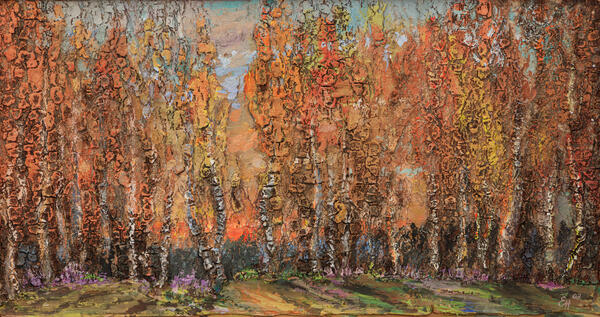The artist Nikolay Eregin from the village of Uyemsky in the Arkhangelsk region has become famous for his relief landscape paintings on birch bark. The artist uses the natural curves of the birch bark: the textured surface transforms into tree trunks, hillsides, or ravines. Nikolay Eregin’s works were acquired by private collections in 27 countries around the world.
In the painting “Autumn”, Eregin depicts a forest with yellow leaves. In the foreground, there are birch trees, followed by trees of other species. The artist deliberately chose colors that would be in harmony with the yellowish hue of the birch bark and the gray knots on it.
The volume is created not only by the natural irregularity of the material that is used as the painting surface but also by the deliberately rough and broad brushstrokes of oil paint. They resemble the painting technique of Expressionist artists.
Birch bark is usually harvested in a special way. First, the upper white layer is removed, then the bark is cut into thinner layers — it splits easily. After that, the sheets are dried under the press from 2 to 3 weeks so that the material becomes flat. If the bark becomes too dry, then it is slightly dampened with water and dried again. These sheets of birch bark are stored in a dry room because they go moldy from moisture.
Before starting work, birch bark is usually primed and then sanded with a fine emery cloth. However, Nikolay Eregin does not always follow these rules: he needs the natural relief of the bark to create a composition.
Birch bark paintings are more fragile than ordinary canvas. They are stored in frames under glass, protected from unstable heating conditions and direct sunlight.
In the painting “Autumn”, Eregin depicts a forest with yellow leaves. In the foreground, there are birch trees, followed by trees of other species. The artist deliberately chose colors that would be in harmony with the yellowish hue of the birch bark and the gray knots on it.
The volume is created not only by the natural irregularity of the material that is used as the painting surface but also by the deliberately rough and broad brushstrokes of oil paint. They resemble the painting technique of Expressionist artists.
Birch bark is usually harvested in a special way. First, the upper white layer is removed, then the bark is cut into thinner layers — it splits easily. After that, the sheets are dried under the press from 2 to 3 weeks so that the material becomes flat. If the bark becomes too dry, then it is slightly dampened with water and dried again. These sheets of birch bark are stored in a dry room because they go moldy from moisture.
Before starting work, birch bark is usually primed and then sanded with a fine emery cloth. However, Nikolay Eregin does not always follow these rules: he needs the natural relief of the bark to create a composition.
Birch bark paintings are more fragile than ordinary canvas. They are stored in frames under glass, protected from unstable heating conditions and direct sunlight.





